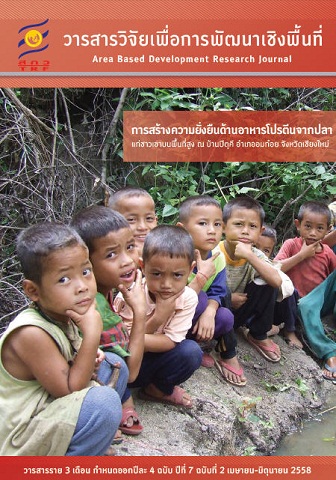การมีส่วนร่วมของเด็กและเยาวชนในการจัดการขยะ : บ้านมั่นคงชุมชนบางบัว เขตบางเขน กรุงเทพมหานคร
Main Article Content
Abstract
บทคัดย่อไม่สมบูรณ์
Children and youth’s participation in waste management : Ban Munkong, Bang Bua Community, Bangkhen District, Bangkok
The Children and Youth Participation in Waste Management Project was part of the research entitled “Waste Management of Youth, the Community Involvement: Ban Munkong, Bang Bua Community, Bangkhen District, Bangkok.” The methodology used in the research was Participatory Action Research: PAR. In addition, it was a Community-Based Research: CBR. The project opened the opportunities for children and youth to practice being the community researchers, encourage them to do civic duty and be responsible for their community. The project focused on the analysis of data on waste management from the beginning to the present on various issues, these are: 1) the situation of community waste, 2) the lessons to be learned from the community waste management, 3) the community participatory in waste management, and 4) the waste management approach for children and youth.
The results were that the waste management has been developed paralleled to the community which was established eighty years ago. The community lands have been changed from the paddy fields to become the urban areas. From the organic wastes which were biodegradable, the community wastes have become more complex, difficult to be destroyed or non-biodegradable. The amount of wastes has been increased tremendously and lack appropriate waste management. When the research team entered the community to launch the project, the community people knew that the children were going to participate in the waste management project. The majority of the community people agreed with the project, because in participating with the project, children and youth spent their time to do civic duty. They would have less time for computer games and helped clean the community. Only 0.7 percent of the respondents disagree with the project. Their reasons were that the areas in the community were limited. They didn’t have enough space for waste storage. After the children and youth participated in the program, it was obvious that their thinking process and behavior had been changed. They also possessed participatory skills, and able to increase their ability to solve the community problem. The conclusion of the research revealed that the sequence of community waste management was divided into two stages. The first stage was the establishment of community involvement in Ban Munkong, Bang Bua Community. The second stage was the establishment of the involvement with the Bang Bua Canal Community Network to empower them in waste management from the upstream, the middle stream to the downstream. In addition, the community set the waste bank with the participatory of Bang Bua Canal Community Network in order to establish a sustainable waste management which would be appropriate for the context of the canal community.
Article Details
Area Based Development Research Journal values copyright protection and licensing to safeguard author rights and facilitate the appropriate dissemination of research. Our policies ensure openness, accessibility, and attribution. Authors retain copyright ownership, and articles are published under a Creative Commons Attribution License (CC BY), allowing sharing, adaptation, and proper attribution. Authors have the freedom to publish under the CC BY license, granting broad reuse and distribution permissions. The journal supports posting articles on third-party repositories, adhering to institutional and funding restrictions. Author guidelines detail copyright and licensing requirements, empowering authors with knowledge about their rights and responsibilities. These policies cultivate an environment of collaboration, openness, and responsible sharing, benefiting authors and the research community while honoring intellectual property rights.


